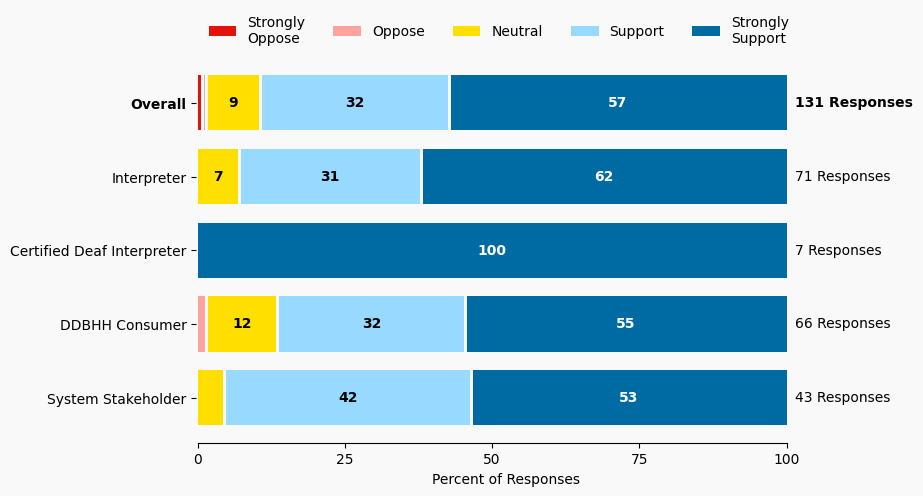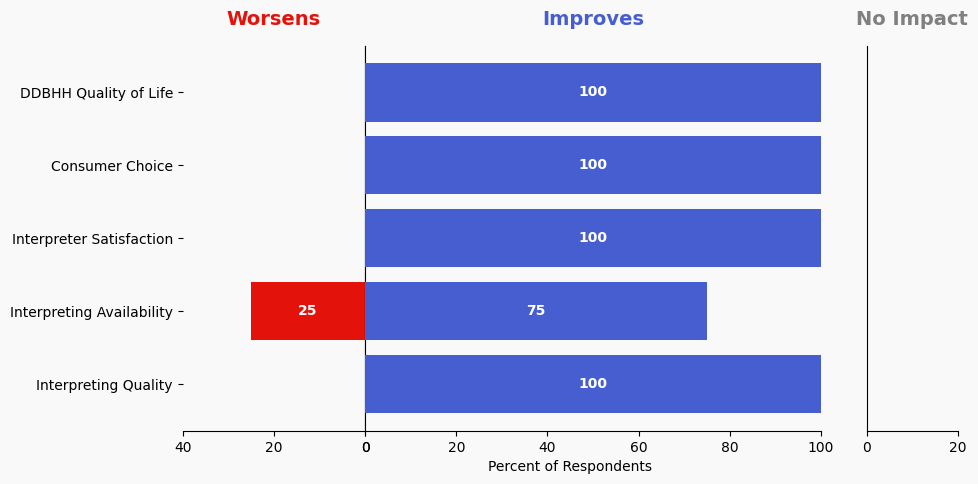45 Minnesota Judicial Branch (MJB) Court Interpreter Program to Revise and Enforce Policy to Honor Hearing Interpreters’ Requests for CDI Teams
Issue: Currently, MJB does not have consistent practice of honoring requests from hearing interpreters (who are contacted first for assignments) to request CDI teams. Some coordinators say that only the DDBHH constituent or the judge is permitted to request a CDI. This is problematic because often judges and DDBHH consumers are not aware that a CDI is an option nor how it might benefit the accuracy of the proceedings. DDBHH constituents are not getting CDIs consistently when they may need a CDI for effective communication.
Proposed Solution: Commission, Disability Law Center and the Olmstead Implementation Office collaborate to work with MJB to reinforce the policy and process for contracting CDIs as needed.
Expected outcome: MJB will provide better services for and avoid any violation of rights for DDBHH Minnesotans. DDBHH Minnesotans will experience justice more on par with their peers who do not have a hearing loss.
Who is impacted: Consumers, court interpreters
Timeline: 6 months

Summary of Support Image Description
The stacked bar charts show how respondents rated their level of support and the total number of responses. The percentage for the five support levels is shown from left to right: Strongly Oppose (Dark Red), Oppose (Light Red), Neutral (Yellow), Support (Light Blue), and Strongly Support (Dark Blue).
Respondents may identify with multiple subgroups. The overall level of support is:
Overall
Strongly Oppose: 1%
Oppose: 1%
Neutral: 9%
Support: 32%
Strongly Support: 56%
Click to see the detailed image description for each subgroup.
Interpreter
Strongly Oppose: 0%
Oppose: 0%
Neutral: 7%
Support: 31%
Strongly Support: 62%
Certified Deaf Interpreter
Strongly Oppose: 0%
Oppose: 0%
Neutral: 0%
Support: 0%
Strongly Support: 100%
DDBHH Consumer
Strongly Oppose: 0%
Oppose: 2%
Neutral: 12%
Support: 32%
Strongly Support: 55%
System Stakeholder
Strongly Oppose: 0%
Oppose: 0%
Neutral: 5%
Support: 42%
Strongly Support: 53%
Overview of Respondents Opting for In-Depth Solution Analysis
After indicating their support level, 4% of the 131 respondents opted in to further assess whether the solution would worsen or improve on five metrics. Of the opt-in reviewers (6 respondents), 83% supported the solution, 16% were neutral on the solution, and 0% opposed the solution.
The remaining 125 respondents did not opt in to further assess the solution. Of these people, 89% support the solution, 8% were neutral on the solution, and 1% opposed the solution.
Reviewer Evaluation of Solution Effectiveness

Solution Effectiveness Image Description
The stacked bar charts show how respondents assessed the effectiveness of this solution based on five metrics. For each metric, the percentage of respondents is shown from left to right: Worsens (Red), Improves (Blue), No Impact (Gray).
DDBHH Quality of Life
Makes It Worse 0%
Makes It Better 100%
No Impact 0%
Interpreter Satisfaction
Makes It Worse 0%
Makes It Better 100%
No Impact 0%
Consumer Choice
Makes It Worse 0%
Makes It Better 100%
No Impact 0%
Interpreting Availability
Makes It Worse 25%
Makes It Better 75%
No Impact 0%
Interpreting Quality
Makes It Worse 0%
Makes It Better 100%
No Impact 0%
Reviewer Feedback and Insights
Interpreter
Comments from Interpreters express concerns that some court administrations avoid using CDIs due to perceived ficial burdens and emphasize the need for education about the advantages of CDIs. One comment highlights that some district courts already honor interpreter requests, but there is a need for statewide consistency.
Deaf, DeafBlind, Hard of Hearing
No comments were submitted.
System Stakeholder
No comments were submitted.
PREVIOUS SOLUTION
44 Minnesota Judicial Branch Court Interpreter Program Hire Staff CDI
Issue: The Minnesota Judicial Branch (MJB) Court Interpreter Program does not have linguistically and culturally relevant expertise to coordinate interpreters for the DDBHH constituents appearing for court proceedings. Particularly as DDBHH constituents in legal settings are sometimes vulnerable persons with disabilities due to language deprivation, the need for linguistically and culturally relevant expertise is necessary for ensuring protection of rights for these Minnesotans. Currently, MJB does not have consistent practice of honoring requests from hearing interpreters (who are contacted first for assignments) to request CDI teams. Some coordinators say that only the DDBHH constituent or the judge is permitted to request a CDI. This is problematic because often judges and DDBHH consumers are not aware that a CDI is an option nor how it might benefit the accuracy of the proceedings.
NEXT SOLUTION
46 Promote K12 Educational Certified Deaf Interpreters
Issue: Some DDBHH students require interpreting skills that can only be provided by Certified Deaf Interpreters (CDIs). Currently, there are challenges with school districts hiring CDIs despite legislation in place to provide for CDIs in classrooms and the funding reimbursement to school districts for CDI services.
Leave a Reply